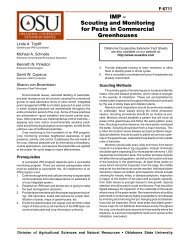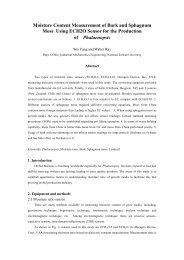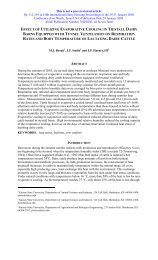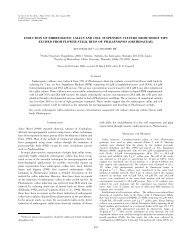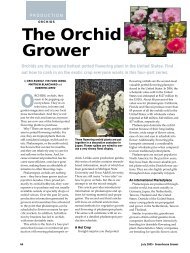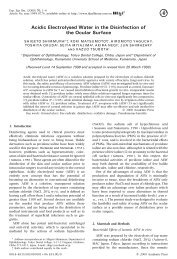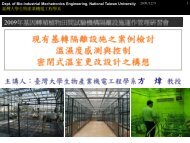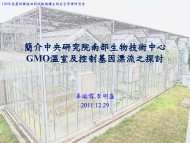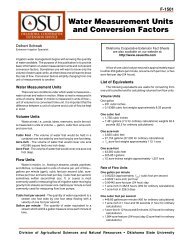CHAPTER 4 HEAT BALANCE OF BARE GROUND
CHAPTER 4 HEAT BALANCE OF BARE GROUND
CHAPTER 4 HEAT BALANCE OF BARE GROUND
Create successful ePaper yourself
Turn your PDF publications into a flip-book with our unique Google optimized e-Paper software.
<strong>CHAPTER</strong> 4<strong>HEAT</strong> <strong>BALANCE</strong> <strong>OF</strong> <strong>BARE</strong> <strong>GROUND</strong>4.1. INTRODUCTIONThe basic component in the system we are considering is bare ground. In thedaytime, its surface is heated by solar radiation when the weather is fine. Thesurface also loses heat to the cold sky by long wave radiation. It can be visualizedthat heat is transferred by conduction to the lower soil layers, neglecting watermovement in the soil. At the surface, not only sensible but also latent heat transferoccurs. These heat flows from the surface to the ambient air are by convection.Therefore, three types of heat transfer are at work in a soil-air system, as shown inFig. 4.1.Figure 4.1. Heat balance of bare groundHeat conduction is heat flow due to molecular movement and is predominant insolid bodies, in which the other two types of heat transfer do not occur. Theamount of heat per unit time per unit area is proportional to the product of thethermal conductivity of the material and the temperature difference, and inverselyproportional to the distance where the temperature difference occurs:Q = -KS * DT / DZ (4.1)45
50 <strong>CHAPTER</strong> 4xlabel('DT (^oC)');ylabel('HI (Wm^{-2}C^{-1})');axis([-inf inf 0 15]);gtext('4.6*DT^{1/3}'); gtext('4.36*DT^{0.25}');gtext('7.2'); gtext('4.6'); gtext('1.38*DT^{1/3}');Figure 4.4. MATLAB scripts to draw Figure 4.3 (HOHI.m).4.3. A MODEL WITH SOLAR RADIATION AND AIR TEMPERATUREBOUNDARY CONDITION (CUC02)The next model is a more sophisticated one which includes air temperature as aboundary condition and the radiation exchange and convective heat transfer at thesoil surface. The outline of the model is shown in Fig. 4.5. In the present model,the soil layers are divided unevenly -- that is, thinnest at the surface and thickertoward the bottom, because the soil temperature does not change so much in deeplayers. The top layer is 1 cm thick but is assumed to be a film surface in thebalance equation. This assumption is justified because in practice the soil surfaceis not smooth and the surface temperature is not well defined and extremely difficultto measure correctly. This thickness can be reduced to 1 mm, for example, ifnecessary.Three new components of heat transfer, all at the surface, are involved, as shownin Fig. 4.5: direct solar radiation (RAD), long wave radiation exchange between thesurface and the sky, and convective heat transfer (HO*(TF-TO)). In the presentmodel the atmospheric emissivity (EPSA) is assumed to be constant. The model islisted in Fig. 4.6, and its result is given in Fig. 4.7.In the present model, the simulation model time clock clk is calculated by themod function (see Fig. 4.6b). The variable clk therefore changes from 0 to 24hours. Solar radiation (RAD) is calculated in ‘solar.m’ in Fig. 4.6d.The result of the simulation is shown in Fig. 4.7. The temperature boundaryconditions are the same as in the preceding model except for air temperature.Although air temperature, one of the boundary conditions, ranges from 5 to 15 o C inthis case, the soil surface temperature is over 23 o C because of solar radiation. Thesoil temperature range is expanded in the daytime and stays more or less the same inthe nighttime as in the preceding model. It can be said that the change in soiltemperature in the simulation is getting closer to the real pattern. Constants RP andEPSA can be changed to 100 and 0.71, respectively, in order to simulate severeradiation cooling in the night, and the results are shown in Fig. 4.7. Lower surfacetemperature than ambient air temperature in the nighttime is clearly shown, althoughthe effect of the initial conditions remains for deeper soil layers.
<strong>HEAT</strong> <strong>BALANCE</strong> <strong>OF</strong> <strong>BARE</strong> <strong>GROUND</strong> 51Figure 4.5. Diagram showing heat balance of soil layers.% Temperature regime in the soil layer CUC02.m% Boundary condition is air temp.% Function required: soil02.mclear all; clcglobal RP EPSAticRP=2000; EPSA=0.75; t0=0; tfinal=48; y0=[10; 10; 10; 10; 10];[t,y]=ode15s('soil02',[t0 tfinal],y0); % Calling function 'soil2.m'h1=findobj('tag','Temperature');close(h1);figure('tag','Temperature','Resize','on','MenuBar','none',...'Name','CUC02.m (T in 5 soil layers given different RP & EPSA)',…'NumberTitle','off','Position',[160,80,520,420]);subplot(2,1,1);plot(t,y(:,1),'b+-',t,y(:,2),'b:',t,y(:,3),'b-.',t,y(:,4),'b--',...t,y(:,5),'b.-');grid off; axis([0, inf, 0, 25]);tit=['RP=' num2str(RP) ' and EPSA=' num2str(EPSA)]; title(tit);ylabel('Soil temperature, ^oC'); legend('TF','T1','T2','T3','T4',-1);RP=100; EPSA=0.71; t0=0; tfinal=48; y0=[5; 5; 6; 7; 8];[t,y]=ode15s('soil02',[t0 tfinal],y0);subplot(2,1,2);h=plot(t,y(:,1),'k+-',t,y(:,2),'k:',t,y(:,3),'k-.',t,y(:,4),'k--',...t,y(:,5),'k.-');set(h,'linewidth',2); grid off; axis([0, inf, 0, 10]);tit=['RP=' num2str(RP) ' and EPSA=' num2str(EPSA)]; title(tit);xlabel('time elapsed, hr');ylabel('Soil temperature, ^oC'); legend('TF','T1','T2','T3','T4',-1);tocdisp('Thank you for using'); disp(' ');
52 <strong>CHAPTER</strong> 4disp('CUC02: Program to calculate Temperatures in soil layers');disp(' given various RP and EPSA.'); disp(' ');disp('You can enter ''close'' to close figure window.');Figure 4.6a. Main program to simulate soil temperatures (CUC02.m).Fig. 4.6a shows the main program of the CUC02 model with the file name of‘cuc02.m’. The commands listed are nearly the same as those in the main programof the CUC01 model, and most statements are for setting constants and parameters.Fig. 4.6b shows the function program ‘soil02.m’ which performs the maincalculations for temperature regime in the soil layer and is similar to the subprogram‘soil01.m’ of CUC01. This program includes two more functions ‘tabs.m’ and‘solar.m’, of which the scripts are listed in Fig. 4.6c and Fig. 4.6d, respectively.The function ‘tabs.m’ calculates (absolute temperature/100) 4 and the function‘solar.m’ gives solar radiation RAD as a sine function and starts at 6 am and ends at6 pm. The maximum value is given as RP, as the amplitude, but the negativevalues of the sine function are cancelled out by the “if” statement at the end.% Subprogram for cuc02 model soil02.m% Functions required: tabs.m and solar.mfunction dy = soil02(t,y)global RP EPSA% RP: Solar radiation amp (kJ/m2/hr), EPSA: Emissivity of air layerTavg=10.0; TU=5.0; TBL=10.0; % Temp (C)KS = 5.5; CS= 2.0E+3; HS = 25.2; SIG = 20.4;% KS (kJ/m/C/hr) and KS/3.6 (W/m/C) also CS (kJ/m3/C)% HS:Heat transfer coeff. at soil surface (kJ/m2/C/hr) = 7(W/m2/C)% SIG:Stefan-Boltzmann constant (kJ/m2/K4/hr) = 5.67(W/m2/K4)% Please note that the above constant is 5.67e-8, the portion of 1e-8% has been performed in function tabs() by (abs.T/100)^4.Z0=0.01; Z1=0.05; Z2=0.1; Z3=0.2; Z4=0.5; % Depths of soil layer (m)ALF = 0.7; % ALF: Absorptivity of solar radiation at soil surfaceEPSF = 0.95; % EPSF:Emissivity of soil surfaceclk = mod(t,24); OMEGA=2.0*pi/24.0; TO = Tavg + TU*sin(OMEGA*(clk-8));TF=y(1);T1=y(2);T2=y(3);T3=y(4);T4=y(5);TO4=tabs(TO); TF4=tabs(TF); % calling function tabs()RAD=solar(RP,OMEGA,clk);% calling function solar()ITF = (ALF*RAD+EPSF*SIG*(EPSA*TO4-TF4)+ ...HS*(TO-TF)+KS*(T1-TF)*2.0/(Z0+Z1))/CS/Z0;IT1 = (KS*(TF - T1)*2.0/(Z0+Z1)+KS*(T2 - T1)*2.0/(Z1+Z2))/CS/Z1;IT2 = (KS*(T1 - T2)*2.0/(Z1+Z2)+KS*(T3 - T2)*2.0/(Z2+Z3))/CS/Z2;IT3 = (KS*(T2- T3)*2.0/(Z2+Z3)+KS*(T4 - T3)*2.0/(Z3+Z4))/CS/Z3;IT4 = (KS*(T3 - T4)*2.0/(Z3+Z4)+KS*(TBL - T4)*2.0/Z4)/CS/Z4;dy=[ITF; IT1; IT2; IT3; IT4];Figure 4.6b. Subprogram to simulate soil temperatures (soil02.m).% Calculation for (absolute Temperature/100) to the power of 4 tabs.mfunction TT4 = tabs(TT)TAA = (TT+273.16)/100.0; TT4 = TAA*TAA*TAA*TAA;Figure 4.6c. Subprogram to simulate soil temperatures (tabs.m).
<strong>HEAT</strong> <strong>BALANCE</strong> <strong>OF</strong> <strong>BARE</strong> <strong>GROUND</strong> 53% Subprogram for the calculation of solar radiation solar.mfunction rad = solar(RP,OMEGA,clk)rad= RP*sin(OMEGA*(clk-6.0)); % Sunrise at 6 am, sunset at 6 pmif rad
54 <strong>CHAPTER</strong> 4Heat flow and water vapor flow can also be related through another number, theLewis number, which is the ratio of thermal diffusivity and the molecular diffusioncoefficient. The Lewis number is almost 0.96 for water vapor and 1.14 for carbondioxide. Thermal diffusivity (KAP, m 2 /hr) is expressed asKAP = K / (RHO * CP) (4.9)where K is thermal conductivity (kJ/m/hr/ o C), RHO is air density (kg/m 3 ) and CP isspecific heat at constant pressure (kJ/kg/ o C). If concentrations are expressed on avolumetric basis, the vapor flux is expressed asF = KMM * ( PHII - PHIS ) (4.10)where F is vapor flux (kg/m 2 /hr), KMM is the vapor flux coefficient (m/hr), andPHII and PHIS are the concentrations of vapor (kg/m 3 ). KMM is expressed asKMM = 1 /∫ zizs(1/DD) dz = SH * DD / Z (4.11)where zs and zi are distances from the soil surface where the concentrations arePHIS and PHII, respectively, DD is the molecular diffusion coefficient (m 2 /hr) andSH is the Sherwood number. zs can be the soil surface.The coefficient KM in eq. 4.3 presents some problems. In some books, KM isrelated to the molecular diffusion coefficient of the mass through anothernon-dimensional number, the Sherwood number, but it varies over a wide range dueto wind speed. Therefore, in the present book, we will ignore the relationshipbetween the molecular diffusion coefficient and KM and define KM as anindependent constant.The relationship between KM and KMM in eq. 4.3 is given asKMM = KM / RHO (4.12)The Lewis number, which is another non-dimensional number, is defined asLe = 3.6 * H / (KM * CP) (4.13)where H is the convective heat transfer coefficient and is the same as that used in eq.4.2. If the Lewis number is equal to 1, the relation between heat flow and masstransfer is expressed asKM = 3.6 * H / CP (4.14)
<strong>HEAT</strong> <strong>BALANCE</strong> <strong>OF</strong> <strong>BARE</strong> <strong>GROUND</strong> 55Since CP = 1 (kJ/kg/ o C), then KM = H * 3.6 (kJ/m 2 /hr/ o C)/(kJ/kg/ o C), that is(kg/m 2 /hr). This relation is convenient because it is not necessary to give the masstransfer coefficient separately. The problem is to find the condition where Le = 1.It is known that Le changes with the ratio of relevant diffusivities and air velocity,and as air velocity over a wetted surface becomes low, Le decreases from 1 to 0.8(Threlkeld, 1962). In the present book, Le is assumed to be 0.9 in all models. Moredetails can be found in the book written by Threlkeld (1962).4.5. A MODEL WITH LATENT <strong>HEAT</strong> TRANSFER (CUC03)In heat transfer under normal conditions, normal air is wet and is defined as themixed ideal gases of dry air and water vapor. It is not difficult to observe this byputting a glass of cold beer on a desk in the summer. The air around the glass iscooled and water vapor in the air condenses at the surface of the glass. This meansthat the air temperature at the surface of the glass is cooled below the dew-pointtemperature of the air at that temperature. This phenomenon can be shown on apsychrometric chart (Fig. 4.8).The psychrometric chart is a powerful tool for understanding the physicalprocesses of the air. Any condition of normal air can be expressed as a point in thearea bounded by three lines: Temperature line (vertical lines), humidity ratio orwater vapor pressure line (horizontal lines), and the curved saturation line (which isshifted according to the atmospheric pressure). The process of the air being cooledby a glass of beer is shown in the figure. The starting condition of the air isassumed to be x in the figure, and the cooling process is shown by the horizontalarrow pointed toward the saturation line. The cross point of this arrow and thesaturation line is the dew-point, and its temperature is read by projecting it on thehorizontal temperature scale. Suppose the surface temperature of the glass is lowerthan the dew-point indicated by the dot on the saturation line. Then the excesswater vapor represented by the difference of the humidity ratio ∆W cannot stay inthe air and is condensed. The humidity ratio shows the amount of water vapor perunit weight of dry air.Fig. 4.9 shows the scripts for calculating temperatures in the soil layer whenlatent heat transfer is involved.
56 <strong>CHAPTER</strong> 4Figure 4.8. Diagrammatic representation of psychrometric chart.% Temperature regime in the soil layer CUC03.m% Latent heat transfer is involved% Function involved: soil03.mclear all;clc; tict0=0; tfinal=48; tfinal=tfinal*(1+eps);y0=[10; 10; 10; 10; 10]; % ini. condition of TF, T1,T2,T3,T4[t,y]=ode15s('soil03',[t0 tfinal],y0); % Calling function soil3.mh1=findobj('tag','Temperature'); close(h1);figure('tag','Temperature','Resize','on','MenuBar','none', ...'Name','CUC03.m','NumberTitle','off','Position',[160,80,520,420]);plot(t,y(:,1),'b^-',t,y(:,2),'gV-',t,y(:,3),'r+-', ...t,y(:,4),'c*-',t,y(:,5),'ko-');grid on; axis([0, inf, 2, 20]);title('EPSA=f(TD), also include the latent heat for evaporation');xlabel('time elapsed, hr');ylabel('Soil temperature, ^oC'); legend('TF','T1','T2','T3','T4',2);toc; disp('Thank you for using '); disp(' ');disp('CUC03: Program to calculate Temperatures in soil layers');disp(' given EPSA=f(TD), also include the latent heat for evaporation.');disp(' '); disp('You can enter ''close'' to close figure window.');Figure 4.9a. Main program to simulate soil temperatures with latent heat exchange (CUC03.m).% Subprogram for cuc03 model soil03.m% Functions involved: FWS.m, TABS.m, SOLAR.m% rp=2000, EPSA=f(TD), also include the latent heat for evaporation% when calculating floor temperaturefunction dy = soil03(t,y)Tavg=10.0; TU=5.0; TBL=10.0; % Temp (C)TD=4.5;%TD: outside dew point temperature, in degree CKS = 5.5; CS= 2.0E+3; HS = 25.2;% KS (kJ/m/C/hr) and KS/3.6 (W/m/C) also CS (kJ/m3/C)
<strong>HEAT</strong> <strong>BALANCE</strong> <strong>OF</strong> <strong>BARE</strong> <strong>GROUND</strong> 57% HS:Heat transfer coeff at soil surface (kJ/m2/C/hr), HS/3.6= 7 (W/m2/C)rp=2000; % rp: Solar radiation amp (kJ/m2/hr)SIG = 20.4; % SIG:Stefan-Boltzmann const. (kJ/m2/K4/hr) = 5.67(W/m2/K4)Z0=0.01; Z1=0.05; Z2=0.1; Z3=0.2; Z4=0.5; % Depths of soil layer (m)ALF = 0.7; % ALF: Absorptivity of solar radiation at soil surfaceEPSF = 0.95; % EPSF:Emissivity of soil surfaceHLG=2501.0; LE=0.9; KM=HS/LE;WO=FWS(TD); % calling function fws(), WO: Humidity ratio (outside air)EPSA=0.711+(TD/100)*(0.56+0.73*(TD/100)); % EPSA:Emissivity of air layerclk = mod(t,24); OMEGA=2.0*pi/24.0; % Time (hr)TO = Tavg + TU*sin(OMEGA*(clk-8));TF=y(1);T1=y(2);T2=y(3);T3=y(4);T4=y(5);TO4=tabs(TO); TF4=tabs(TF); %calling function tabs()RAD=solar(rp,OMEGA,clk); %calling func. solar() for simulated radiationWF=fws(TF);%calling function fws()%WF: Humidity ratio at soil surface (assumed saturated)ITF=(ALF*RAD+EPSF*SIG*(EPSA*TO4-TF4)+HS*(TO-TF)+HLG*KM*(WO-WF)+...KS*(T1-TF)*2.0/(Z0+Z1))/CS/Z0;IT1 = (KS*(TF-T1)*2.0/(Z0+Z1)+KS*(T2-T1)*2.0/(Z1+Z2))/CS/Z1;IT2 = (KS*(T1-T2)*2.0/(Z1+Z2)+KS*(T3-T2)*2.0/(Z2+Z3))/CS/Z2;IT3 = (KS*(T2-T3)*2.0/(Z2+Z3)+KS*(T4-T3)*2.0/(Z3+Z4))/CS/Z3;IT4 = (KS*(T3-T4)*2.0/(Z3+Z4)+KS*(TBL-T4)*2.0/Z4)/CS/Z4;dy=[ITF; IT1; IT2; IT3; IT4];Figure 4.9b. Subprogram to simulate soil temperatures with latent heat exchange (soil03.m).% Calculate saturated humidity ratio FWS.mfunction WWW=FWS(TTT)Patm=101325; TQQ=TTT + 273.16; T10=TQQ/100.0;if TTT>0A=-5800.2206/TQQ+1.3914993-0.04860239*TQQ;B=0.41764768*T10*T10-0.014452093*T10*T10*T10;C=6.5459673*log(TQQ);elseA=-5674.5359/TQQ+6.3925247-0.9677843*T10;B=0.62215701E-2*T10*T10+0.20747825E-2*T10*T10*T10;C=-0.9484024E-4*T10*T10*T10*T10+4.1635019*log(TQQ);endBETA=A + B + C; PWS=exp(BETA); WWW=0.622*PWS/(Patm-PWS);Figure 4.9c. Subprogram to simulate soil temperatures with latent heat exchange (fws.m).In this model (CUC03), the boundary condition at the surface was modified to beclose to that in reality; that is, latent heat transfer has been included in this model.The rest of the model from section 4.3 is unchanged (see Fig. 4.1). Evaporationfrom the soil surface is now in the model and the latent heat transfer(HLG*KM*(WF-WO)) has been added. The humidity ratio of the soil surface isassumed saturated at the soil surface temperature and is calculated by using thesaturation curve in Fig. 4.8 (see also ASHRAE, 1985).
58 <strong>CHAPTER</strong> 4Figure 4.10. Simulated results of CUC03 model.The structure of the model is similar to the one in section 4.3. In the presentprogram, there are six unknown variables, TF, T1 - T4, and WF; and 6 equations.TF = f 1 (TF, T1,Wf), T1 = f 2 (TF, T1, T2), T2 = f 3 (T1, T2, T3)T3 = f 4 (T2, T3, T4), T4 = f 5 (T3, T4), WF = f 6 (TF)In the present model shown in Fig. 4.9, the new function FWS in subprogram‘fws.m’ (see Fig. 4.9c) for calculating the saturated humidity ratio is included.This semi-empirical expression calculates saturated humidity ratio (dummyargument is WWW) if a wet-bulb temperature (dummy argument is TTT) is given(after ASHRAE, 1988). Other approximations of the curve are also available withless accuracy (see CUC150).One of the new boundary conditions is dew-point temperature (TD) of the air.Using TD, humidity ratio of the air (WO) as well as atmospheric emissivity (ESPA)are calculated by eq. 4.18. Humidity ratio at the soil surface (WF) is alsocalculated using the function FWS.The results of the model are given in Fig. 4.10. In the present case, the soil isassumed to be completely wet, that is, saturated at the soil surface. Therefore,potential evaporation takes place and cools down the soil surface temperature. Themaximum temperature of the surface is just above 18 o C, which is 5 o C lower than inthe case presented in section 4.3. Deeper soil layers have little effect on thesurface.
<strong>HEAT</strong> <strong>BALANCE</strong> <strong>OF</strong> <strong>BARE</strong> <strong>GROUND</strong> 594.6. RADIATION <strong>BALANCE</strong>Radiation is emitted from a body whose temperature is above 0 K; in the presentsituation, that is, everything emits radiation. Radiation is always considered abalance. For the radiation balance of the bare ground, net radiation is defined as thedifference between incoming radiation from the sky and outgoing radiation from theground. In the daytime, the balance includes solar radiation, of course. The netradiation only for long wave radiation is called effective radiation. In the nighttime,net radiation is equal to effective radiation.Radiation is like light; it can be considered to travel in a straight line. If twobodies, such as the sky and the ground, are placed face to face without anyintermediary, the radiation exchange between these two bodies is one to one. Theheat balance systems we have so far considered are of this type -- that is, the bodiesinvolved are the flat soil surface and the sky. These two surfaces can be consideredinfinite and parallel. Therefore, the radiation emitted from one surface alwaysenters the other.But when another body such as a building is involved, as shown in Fig. 4.11, partof the radiation from the ground cannot go directly to the sky, and vice versa. Thissituation can be visualized by looking at the figure from the direction shown by theword ‘eye’. Suppose the building is infinite in the direction perpendicular to thepage: then half of the sky and half of your perspective are occupied by the face ofthe building. The ground does receive half of the radiation from the sky, but it alsoreceives half of that from the building surface. In this case, it is said that the viewfactor of the ground to the sky is 0.5 and the view factor of the ground to thebuilding is 0.5. On the other hand, if you move your eye from the ground to thebuilding surface, it is clear that the view factor of the building to the sky is 0.5. Ofthe three items being discussed, normally the sky has the lowest temperature and thesmallest amount of long wave radiation. On calm clear nights, the soil surface iscooled by radiation because of this fact. However, if half of the sky is blocked by alarge building such as shown in Fig. 4.11, the soil surface will be warmer becausemore radiation will travel from the building surface to the soil surface. Therefore,it is very important to take into account view factor relations when we analyzeradiation exchange among surfaces of different surface temperatures.View factor takes into consideration the area of another body with which theradiation exchange takes place in relation to the total hemisphere of the exchangesurface. This relationship is three-dimensional, and the geometric relationshipbetween the two bodies is not simple. A simple way to calculate the view factor isto project all the areas onto the horizontal surface with which the basic surface isinvolved; then the hemisphere becomes the unit circle and the projected area of thebody is the view factor, as shown in Fig. 4.12. The important relationship is that
60 <strong>CHAPTER</strong> 4n∑j=1view factor(i, j) = 1 (4.15)Figure 4.11. Radiation exchange amongthe sky, the ground and a building.Figure 4.12. Geometrical representation ofview factor.which means that the summation of the view factors of the arbitrary surface i to anysurface j including itself is equal to 1. The self view factor is defined when thesurface is concave.If we look at protected cultivation systems closely, most parts of the systems arenot flat surfaces. Rows, tunnels and houses all have curved surfaces of differenttemperatures. Therefore, it is important to consider view factors in detailedanalyses of these systems. However, in the present book, in order to simplify theproblem, view factors are not taken into account in any model; it is assumed that allsurfaces are infinitely flat. View factor analyses have been conducted in somemodels (e.g., Takakura et al., 1971), which can be consulted when necessary.
<strong>HEAT</strong> <strong>BALANCE</strong> <strong>OF</strong> <strong>BARE</strong> <strong>GROUND</strong> 61Table 4.1. Emissivities of various surfaces (after Seller, 1965).A. Water and Soil Surfaces C. VegetationWater 0.92-0.96 Alfalfa, dark green 0.95Snow, fresh fallen 0.82-0.995 Oak leaves 0.91-0.95Ice 0.96 Leaves and plantsSand, dry light 0.89-0.90 0.8 µm 0.50-0.53Sand, wet 0.95 1.0 µm 0.50-0.60Gravel, coarse 0.91-0.92 2.4 µm 0.70-0.97Limestone, light gray 0.91-0.92 10.0 µm 0.97-0.98Concrete, dry 0.71-0.88 D. MiscellaneousGround, moist, bare 0.95-0.98 Paper, white 0.89-0.95B. Natural Surfaces Glass, pane 0.87-0.94Desert 0.90-0.91 Bricks, red 0.92Grass, high dry 0.90 Plaster, white 0.91Fields and shrubs 0.90 Wood, planed oak 0.90Oak woodland 0.90 Paint, white 0.91-0.95Pine forest 0.90 Paint, black 0.88-0.95Paint, aluminum 0.43-0.55Aluminum foil 0.10-0.5Iron, galvanized 0.13-0.28Silver, highly 0.20polishedSkin, human 0.954.7. LONG WAVE RADIATIONRadiation is emitted from any body whose temperature is above 0 K, including thesky and the earth's surface. Radiation emitted from a body whose temperature is inthe ordinary range (0 – 30 o C) has a peak of density in the longer wavelengths shownin Fig. 4.13 called long wave radiation.Emissivity and temperature of the atmosphere are not simple to determine;neither is long wave radiation from the sky. Within a rather thin layer such as 10 mor so, it can be assumed that the air is transparent to long wave radiation. Thisassumption, however, cannot be applied to the whole layer of the atmosphere aroundthe earth. Atmospheric radiation is a function of water vapor, carbon dioxide andozone content, but in most cases, the effects of carbon dioxide and ozone areneglected, mainly because of their thin, very low emissivities.A large number of radiation charts have been developed for computingatmospheric radiation (e.g., Seller, 1965). They need data that are not available,and the techniques for computing the radiation are not simple. Empirical equations,which are less accurate, are more practical. Brunt’s equation (in van Wijk, 1966) is
62 <strong>CHAPTER</strong> 4RD = (A + B * sqrt(WO)) * SIG * ATA 4 (4.16)where RD is downward long wave radiation (atmospheric radiation) (W/m 2 ), A andB are empirical constants related to each location with values of 0.53 and 0.06,respectively, for various locations in U.S.A., WO is humidity ratio (kg/kg DA), andATA is absolute air temperature (K) at the screen height. Since A and B aredependent on temperature and water vapor of the atmosphere, these constants mustbe determined at the place where this equation is applied.Figure 4.13. Long wave radiation from the sky (after Gates, 1962).A similar empirical equation was reported based on observation at six locationsin the U.S.A. by Martin and Berdahi (1984):RD = EPSA * SIG * ATA 4 (4.17)EPSA = 0.711 + 0.56 * TD / 100 + 0.73 * (TD / 100) 2 (4.18)where EPSA is atmospheric emissivity and TD is dew-point temperature ( o C) at thescreen height. Emissivities of various materials are summarized in Table 4.1.
<strong>HEAT</strong> <strong>BALANCE</strong> <strong>OF</strong> <strong>BARE</strong> <strong>GROUND</strong> 63MATLAB FUNCTIONS USEDclcClear the Command Window and home the cursor.clear Clear variables and functions from memory.clear all Remove all variables, globals, functions and MEX links.exp Exponential. exp(X) is the exponential of the elements of X.for…. end Repeat statements a specific number of times. The general form is:for variable = expr, statement, ..., statement endgtext Place text with mouse. gtext('string') displays the graph window,puts up a cross-hair, and waits for a mouse button or keyboard keyto be pressed.if..else..end IF statement condition. The general form is:if expressionstatementselseif expressionstatementselsestatementsendlog The natural logarithm of the elements of X.arithmeticoperatorsrelationaloperatorslogicaloperators+*^\.\===&~|xorPlusMatrix multiplyMatrix powerBackslash or leftmatrix divideLeft array divideEqualLess thanLess than or equalNot equalGreater thanGreater than or equal-.*.^/Logical ANDLogical NOTLogical ORLogical EXCLUSIVE OR./MinusArray multiplyArray powerSlash or right matrixdivideRight array divide
64 <strong>CHAPTER</strong> 4PROBLEMS1. If you look carefully at the periodic changes of the deeper soil layers in Fig.4.7, a trend of temperature rise or fall is clear. Explain the reason for this,then change the initial conditions for all soil layers to more reasonable values.Note: Two days' run is not enough to check this. Run for a week at least.2. Modify the program CUC02, applying the convective heat transfer coefficientat the soil surface (HS) as a function of wind speed. Use the followingrelationships: HS = 2.8 + 1.2 * V and V = 2.0 + 2.0 * sin (OMEGA * clk).3. Variable PWS (in Pa) in the function FWS.m calculates saturated vaporpressure as a function of given temperature (see Fig. 4.9c). FunctionVAPRES (in mb) in the CUC151 program (see Chapter 10) uses a differentapproximation. Compare these two methods of calculating saturated vaporpressure in the temperature range of 0 – 40 o C.4. Explain the reason why the front glass of a car facing the sky on a winternight is frosted, while that of a car facing a tall building is not frosted.5. Calculate RD in eqs. 4.16 and 4.17 for the dew-point temperature range 0 –20 o C and air temperature assumed 30 degree C. Program ‘FWS.m’ is requiredto derive humidity ratio from dew-point temperature.6. Modify the model CUC01, assuming the thermal conductivity of soil KS isnot a constant and is a function of soil temperature (TEMP), expressed as: KS= 5.5 + 0.1 * TEMP.7. Modify the model CUC03, assuming the temperature of the sky follows theSwinkbank model. The expression is: Tsky = 0.0552 * (TO) 1.5 . Both Tsky andTO are expressed in Kelvin. Use Tsky for the calculation of the long waveradiation from the sky.



